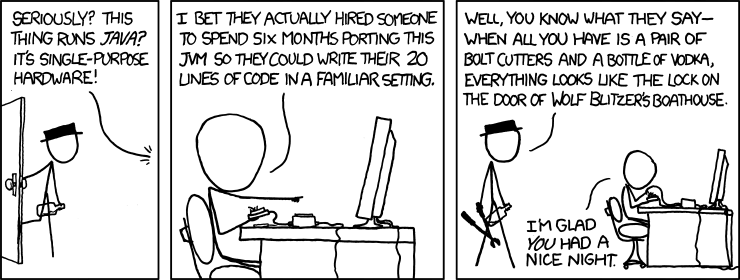You’re probably familiar with Abraham Maslow’s maxim, “It is tempting, if the only tool you have is a hammer, to treat everything as if it were a nail.” It is actually a variation on a concept written by Abraham Kaplan two years earlier: “I call it the law of the instrument, and it may be formulated as follows: Give a small boy a hammer, and he will find that everything he encounters needs pounding.”
You’ve likely also heard “Never box a boxer, never wrestle a wrestler,” an adage attributed to various martial arts figures, depending on whom you ask. Each of these fighting styles becomes its practitioner’s Golden Hammer: a boxer and a wrestler will each rely on his or her respective skill set, no matter the situation. I’m generalizing, of course, but this is a fighting reality and is especially evident in many MMA events. A fighter who is dominant in one aspect of the fight game (boxing, kickboxing, wrestling, BJJ) will try to keep the fight in that mode at all costs, even when his or her corner is screaming otherwise.
Our system of Krav Maga is designed with this in mind, so our techniques are well-rounded and cover both stand-up and groundfighting. Standing and trading blows with a boxer or groundfighting with a wrestler is not an effective means of finishing the fight and going home safe. However, even within our versatile training, we are no less subject to the Law of the Instrument. Our Golden Hammer? Almost without exception, it’s knee strikes. Early on in our Krav Maga training, most of us discover that knees are devastating close-range weapons; true fight-finishers. Knees become the go-to combative, and most of us throw them regardless of how our partner is reacting.
Does that mean that we should ease up on the knees? No! Just don’t try to force their application in a scenario where a more suitable tool could be used. Try to keep these important points in mind:
- Am I using my nearest weapon against the nearest target?
- Am I using the most effective weapon against the most vulnerable target?
- Am I unnecessarily leaving openings in my defenses in order to throw this type of combative?
If knee strikes fit those criteria, then keep these points in mind (see also Knees in Review):
- Establish a secure control position with your elbow down, forearm against the neck, weight down, hips and legs back in a strong fighting stance.
- See within the Fight. Your opponent might instinctively be covering his or her midsection, so instead of automatically launching a knee to the solar plexus, hunt for the nearest open target.
- Once you’ve homed in on an open target, it’s tempting to rip off a half dozen knees to same place, but your opponent is going to wise to this pretty quickly. Think about alternating between high and low targets to create new openings.
- It bears repeating: at every stage, be mindful of your hip and leg positioning! Don’t be a textbook takedown dummy!



